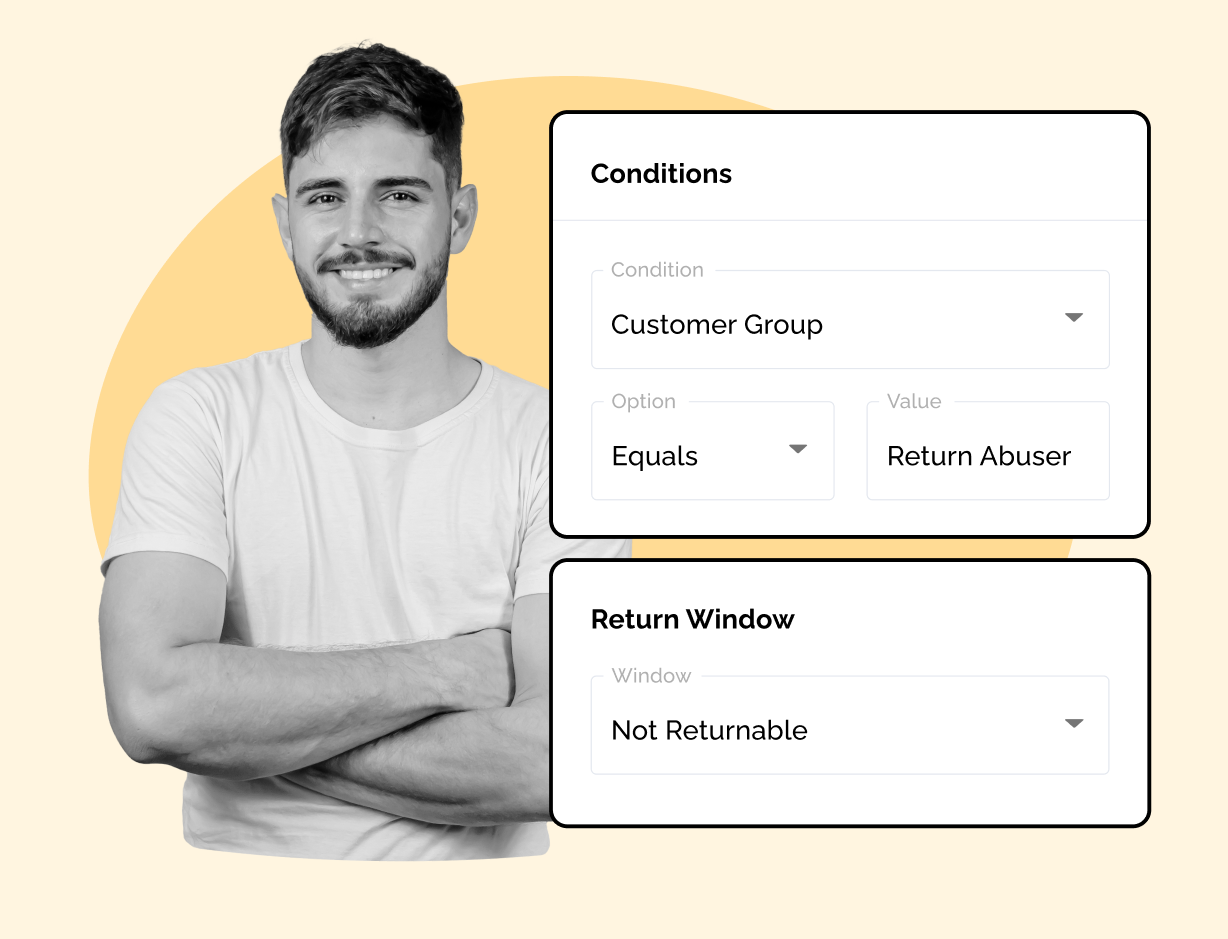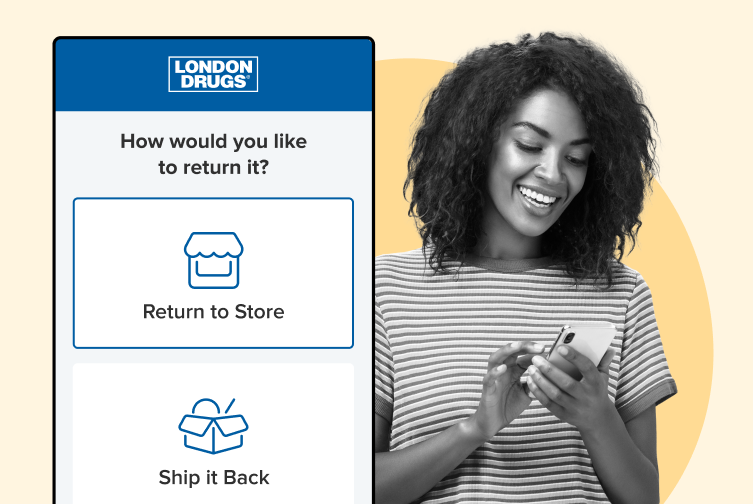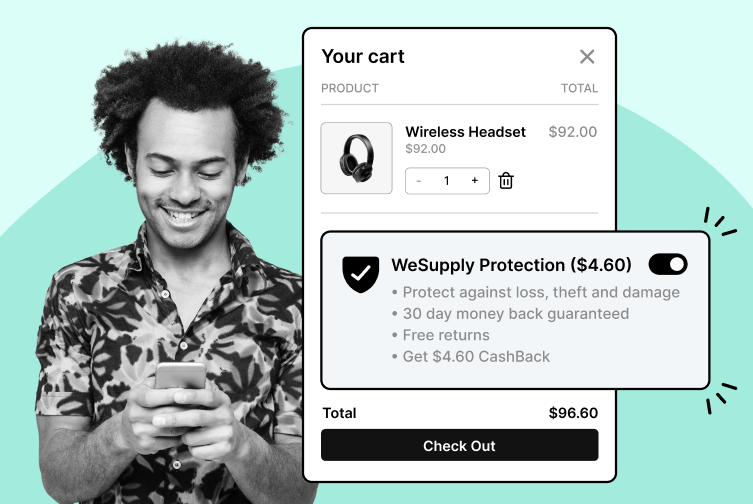
How to Manage Promo Bundle Returns Without Losing Revenue
Learn how to effectively manage promo bundle returns while protecting your revenue. Discover practical tips to streamline your process!
Shipping, Tracking & Notifications
Boost customer experience and reduce support tickets
Realtime order and shipment tracking
Proactive order and shipping notifications
AI-Enhanced Discounted Labels
Predictive pre-purchase estimated delivery dates
Self-Serivce branded order tracking
Effortless experience delivered
Identify and Resolve Order Issues
Realtime order and shipment tracking
Make returns profitable and delight customers
Flexibility to define any return destinations & conditions
Simplify returns for your customers and team
Incentivize exchanges over returns
Returns management made easy for your team
Returns management made easy for your team
Easy claims and smart upsells
Understand why your customers are returning
In-Store & Curbside Pickup
Unify the online and the in-store experience
Hassle-free pickup experience for customers
In-Store dashboard to keep operations streamlined
In-Store and Online orders unified
Drive foot-traffic to your stores
Shipping, Tracking & Notifications
Boost customer experience and reduce support tickets
Realtime order and shipment tracking
Proactive order and shipping notifications
AI-Enhanced Discounted Labels
Predictive pre-purchase estimated delivery dates
Self-Serivce branded order tracking
Effortless experience delivered
Identify and Resolve Order Issues
Realtime order and shipment tracking
Make returns profitable and delight customers
Flexibility to define any return destinations & conditions
Simplify returns for your customers and team
Incentivize exchanges over returns
Returns management made easy for your team
Returns management made easy for your team
Understand why your customers are returning
In-Store & Curbside Pickup
Unify the online and the in-store experience
Hassle-free pickup experience for customers
In-Store Dashboard to keep operations streamlined
In-Store and Online orders unified
Drive foot-traffic to your stores
Boost customer experience and reduce support tickets
Realtime order and shipment tracking
Proactive order and shipping notifications
AI-Enhanced Discounted Labels
Predictive pre-purchase estimated delivery dates
Self-Serivce branded order tracking
Effortless experience delivered
Make returns profitable and delight customers
Flexibility to define any return destinations & conditions
Simplify returns for your customers and team
Incentivize exchanges over returns
Returns management made easy for your team
Equip your team for precise return checks.
Easy claims and smart upsells
Understand why your customers are returning
Unify the online and the in-store experience
Hassle-free pickup experience for customers
In-Store Dashboard to keep operations streamlined
In-Store and Online orders unified
Drive foot-traffic to your stores
Find the answer to all your questions
Take a step by step trip through our functionality to see how we can improve your ecommerce processes.
Explore the most comon questions about WeSupply
Calculate the ROI that WeSupply can bring you
Request a no strings attached review of your current shopping experience and missed conversion opportunities
Read actionable articles on how to optimize your post-purchase experience and decrease support tickets
Get inspired by stories of how our customers implemented an effortless post-purchase experience
Wondering if WeSupply is a good fit for you? Read through our use cases to see how we can help you increase conversion & improve CX!
A Deep Dive into Top Companies' Order Tracking & Returns Strategy
Find the answer to all your questions
Explore the most comon questions about WeSupply
Calculate the ROI that WeSupply can bring you
Request a no strings attached review of your current shopping experience and missed conversion opportunities
Take a step by step trip through our functionality to see how we can improve your ecommerce processes.
Read actionable articles on how to optimize your post-purchase experience and decrease support tickets
Get inspired by stories of how our customers implemented an effortless post-purchase experience
A Deep Dive into Top Companies' Order Tracking & Returns Strategy
Wondering if WeSupply is a good fit for you? Read through our use cases to see how we can help you increase conversion & improve CX!

Promo codes, discounts, and special offers are vital tools in any e-commerce business’s arsenal. Companies use many forms of promo codes, such as evergreen, test, and affiliate codes, but face significant challenges in managing and securing these codes against abuse.
From serial returners who abuse free shipping and promo discounts, to fraudsters exploiting multiple accounts, promotion abuse can take many forms including percentage or flat discounts, stacking codes, and exploiting automation or cookies which can quietly erode your profit margins. Worse, it can lead to inaccurate inventory levels, skewed analytics, and weakened customer trust. Companies must pay close attention to detail in their promo management to prevent these issues.
From serial returners who abuse free shipping and promo discounts, to fraudsters exploiting multiple accounts, promotion abuse can take many forms including percentage or flat discounts, stacking codes, and exploiting automation or cookies which can quietly erode your profit margins. Worse, it can lead to inaccurate inventory levels, skewed analytics, and weakened customer trust. Companies must pay close attention to detail in their promo management to prevent these issues.
Unlike traditional approaches that rely on manual processes and static rules, smart logic leverages automation and advanced analytics to more effectively prevent promo abuse. This article explores how smart logic works, why it matters, and how to implement it effectively.
Promo abuse isn’t just about using the same coupon twice. It’s a broader issue that encompasses these forms of abuse, such as:
Creating multiple fake accounts to reuse first-time discounts
Using bots to scan and apply coupon combinations
Buying products using heavy discount offers, then returning them after use (wardrobing)
Stacking coupons in unintended ways to exploit loopholes
Switching products during returns to get a refund on a more expensive item
Promo abuse undermines the goal of encouraging future purchases and building customer loyalty.
Apps and mobile apps can be exploited for promo abuse, especially in e-commerce, where users leverage these tools to find and apply discounts or manipulate promotional rules.
These practices don’t just cost money they create logistical headaches, damage brand integrity, and make it harder for legitimate customers to enjoy the benefits of your promotions.
In more troubling cases, promo abuse is linked to personal abuse. For example, in relationships involving domestic violence, abusers may use shared accounts or promo offers to track victims’ purchases. Technology enables abusers to target more victims through digital means, using various forms of technology-facilitated abuse. Social media can also be a platform for both abuse and fraud detection in the context of promo abuse. These edge cases highlight the importance of using data and smart logic not just for fraud prevention but also for user protection.
Returns are already a significant pain point for retailers, and when promotions are involved, things can quickly get complicated. For example:
A shopper buys a discounted item and then returns it after using it briefly.
A customer exploits free return shipping policies to cycle through products with no intent to keep them.
Users purchase during promotional events, return items, and then re-buy them under a different promo to game the price.
After a flash sale, some customers return items and attempt to use leftover coupon codes, especially if those codes are not promptly deleted or deactivated.
Before smart logic can take action, it needs information. Data collection is the first step in identifying and preventing abuse. E-commerce platforms can gather data through multiple channels, such as:
Website and app analytics (user behavior, device type, browsing history)
Order history and return frequency
Coupon code usage logs
IP addresses and geolocation data
Customer account data (email, payment method, shipping address)
This data can be accessed by unauthorized parties if not properly secured, highlighting the importance of robust security measures.
Developers play a crucial role in building and maintaining secure data collection and management systems, ensuring that sensitive information is protected. For example, a developer may implement a primary key in the database schema to uniquely track coupon code usage and prevent duplication or misuse.
Expertise and knowledge in data privacy and security are essential for designing systems that comply with regulations and protect user data. Reliable service and supporting services are fundamental to maintaining secure and efficient data collection infrastructure.
Verifying customer data using trusted sources and tools like Google can help prevent abuse and ensure the accuracy of collected information.
By connecting these data points, you can build a 360-degree view of each customer. For example, if multiple accounts share the same shipping address or device ID, it might indicate promo abuse through account cycling.
To ensure compliance with data privacy regulations like GDPR and CCPA, businesses must collect and store data transparently, giving users control over their personal information.
E-commerce platform security is the backbone of a trustworthy online store. As a store owner, you face constant threats from malicious users seeking to exploit vulnerabilities for financial fraud or data misuse. Protecting your customers’ sensitive information and ensuring the integrity of every transaction should be a top priority.
Start by controlling access to your store’s backend only authorized users should be able to collect data, manage transactions, or make system changes. Implementing strong authentication protocols and role-based permissions helps prevent unauthorized access and reduces the risk of internal and external threats.
Regular security audits and penetration testing are industry best practices that allow you to identify potential security issues before they can be exploited. When vulnerabilities are identified, immediate action is crucial to fix them and prevent further risk. Using secure data collection and transmission protocols, such as HTTPS, ensures that customer details and transaction data are protected from interception and misuse.
Additionally, monitoring your system for unusual activity such as unexpected access attempts or suspicious transaction patterns enables you to respond quickly to emerging threats. By prioritizing e-commerce security, you not only reduce the risk of fraudulent transactions and financial losses but also build lasting trust with your customers. Staying ahead of security threats is an ongoing process, but with the right controls and best practices in place, your store can remain a safe and reliable destination for internet users.
Smart logic refers to using rule-based and AI-powered systems that detect and respond to suspicious behaviors automatically. Smart logic automates processes for detecting and responding to abuse, streamlining workflows and improving efficiency. When automating decisions, it is important to ensure that smart logic aligns with ethical values, such as fairness and respect for privacy. In the context of promo abuse during returns, it can include:
Flagging customers who exceed a certain number of returns in a month
Blocking coupon usage for accounts with prior promo abuse
Preventing returns if the order was placed using stacked or expired promos
A developer is responsible for creating and maintaining these conditional rules to ensure the coupon system works securely and efficiently.
Detecting unusual order-return patterns (e.g., multiple returns after flash sales)
Monitoring shared devices or payment methods across accounts
Identifying sudden spikes in return activity after promotions
Behavioral analytics can also help identify insider threats related to promo abuse, providing an additional layer of protection against internal security breaches.
Learning patterns of serial returners and suspicious promo behavior over time
Adjusting fraud detection thresholds dynamically based on ongoing data
Assigning risk scores to transactions based on historical patterns
By combining these tools, retailers can automatically allow low-risk returns while flagging or blocking high-risk transactions, striking the right balance between fraud prevention and customer satisfaction.
The effectiveness of AI-powered fraud detection systems relies heavily on the expertise of developers, who design, implement, and maintain these solutions to ensure robust security and optimal performance.
One of the simplest yet most effective tactics to prevent promo abuse is setting stricter controls on how promotions are applied. Examples include:
Limiting promo codes to one use per customer or account
Requiring account verification (e.g., SMS or email confirmation) before applying discounts
Blocking multiple promotions from being applied to the same transaction
Using time limits or expiration dates for promo codes
Limiting the form in which discounts can be applied, such as restricting certain discount types (e.g., ‘Buy X Get Y Free’) to specific products or order values
Incorporating these limits within your smart return logic helps ensure that customers can’t reapply promo codes during returns to game the system. For instance, you might block return requests if a promo code was already redeemed and the customer has a history of excessive returns. Additionally, always secure the input form where promo codes are entered to prevent abuse through form manipulation or injection attacks.
Smart logic enables you to build automated return flows that respond in real time. Decision trees can be customized based on:
Product category and price point
Promo code used during purchase
Return frequency and reason
Customer profile (new vs. returning, VIP vs. flagged)
Apps can be used to automate and manage return processes, making it easier for both retailers and customers. Such apps often offer advanced features for return management and fraud prevention.
For example:
A loyal customer requesting a return on a full-price item might receive an instant refund.
A new customer returning a discounted item may be offered store credit only.
A flagged account may be routed for manual review before return approval.
These smart workflows not only reduce fraud but also streamline the return process for trustworthy customers, improving operational efficiency.
To make smart logic even more powerful, many retailers integrate third-party services that specialize in:
Fraud detection (e.g., Signifyd, Sift)
Behavioral analytics (e.g., FullStory, Hotjar)
Personalized upsells and recommendations (e.g., Nosto)
Order tracking and returns management (e.g., WeSupply)
Integrating these services not only enhances fraud detection but also streamlines processes for abuse detection and prevention by automating workflows and improving operational efficiency.
By connecting your e-commerce platform to these tools, you can gather better insights and automate decision-making with more confidence.
For example, WeSupply allows you to track returns in real time, identify patterns of abuse, and embed personalized upsell recommendations into return pages turning a potential loss into a revenue opportunity.
Persistent abusers often find new ways to exploit coupon codes and commit financial fraud, making it essential for e-commerce businesses to adopt advanced prevention strategies. A robust coupon code system is your first line of defense set clear expiration dates, usage limits, and restrictions on specific categories to ensure codes can’t be misused across multiple purchases or accounts.
Monitoring user behavior is equally important. By analyzing data on how users interact with your store such as repeated attempts to use the same code, rapid-fire purchases, or patterns that deviate from normal activity you can identify and flag potential abuse. Systems that log and review these details help you act quickly to prevent fraudulent transactions before they impact your bottom line.
Leveraging artificial intelligence and machine learning enables your store to stay ahead of evolving threats. These technologies can identify new abuse tactics by continuously learning from user data and adapting to emerging risks. For example, AI can spot subtle patterns that indicate a user is attempting to bypass coupon restrictions or orchestrate fraudulent purchases.
Combining these advanced strategies gives you more control over your promotional campaigns and helps protect your store from potential losses. By proactively identifying and responding to abuse, you not only safeguard your revenue but also maintain a fair and positive experience for legitimate customers. In the ever-changing landscape of e-commerce, staying vigilant and adaptive is key to outsmarting malicious users and ensuring the long-term value of your promotions.
While preventing promo abuse is essential, it’s equally important not to alienate good customers. Overzealous fraud detection can lead to false positives, unnecessary friction, and negative reviews, with some frustrated customers even leaving one star ratings.
Smart logic allows businesses to walk this fine line by:
Using adaptive thresholds based on risk scores
Offering alternative resolutions (e.g., store credit vs. refund)
Escalating only suspicious cases to human review
Providing clear communication during the return process
By balancing automation with empathy, retailers can maintain trust while protecting their margins.
One often overlooked area is how promo abuse intersects with sensitive scenarios like domestic violence. In some abusive relationships, shared accounts and payment methods may be used to monitor or control victims. For instance, an abuser may exploit return policies and promo codes to manipulate household spending or track purchases. Technology can also enable abusers to target more victims by facilitating ongoing surveillance, coercive control, and harassment beyond traditional boundaries.
Retailers have an ethical responsibility to ensure their systems can detect and address such misuse, aligning promo abuse prevention with societal and ethical values. Staff should have the knowledge to recognize and respond to sensitive contexts like domestic violence, ensuring that interventions are both effective and empathetic. Smart logic can be configured to:
Flag repeated returns or coupon redemptions from shared accounts
Enable anonymous returns for at-risk users
Escalate concerning patterns to specialized support teams
Combining technology with compassion helps businesses not only prevent fraud but also protect vulnerable customers.
The current state of promo abuse prevention shows that while many retailers have implemented basic controls, there is still significant variation in awareness and effectiveness of advanced techniques across the industry. Promo abuse prevention is an evolving field. Here are some best practices that retailers should adopt now, along with a glimpse into what’s ahead:
Best Practices:
Set clear return and promo code policies visible at checkout
Verify customer identity during promo redemption
Use fraud scoring and machine learning to assess risk
Limit promo stacking and implement usage caps
Regularly audit promo campaign performance and abuse rates
Consult trusted sources when developing and updating best practices to ensure accuracy and reliability
Emerging Trends:
AI-generated personalized promo codes
Blockchain for verifiable promo redemption history
Real-time collaboration between e-commerce, fraud, and support teams
Privacy-first data collection tools that support fraud detection
To stay updated on emerging trends and research, use Google, Google Scholar, and other tools to supplement academic and industry resources. By staying ahead of trends and continually optimizing logic rules, businesses can adapt faster than fraudsters.
To effectively prevent promotion abuse during returns, you need more than manual reviews and generic return policies. You need a smart, dynamic system that understands your customers and adapts in real time. Attention to detail is crucial when implementing smart logic, as even small oversights can lead to vulnerabilities.
Here’s what smart logic brings to the table:
Combines data from multiple sources for a full customer view
Uses AI and behavioral analytics to detect abuse patterns
Enables conditional logic to automate return approvals or blocks
Limits promo usage through controlled redemption settings
Balances fraud prevention with customer satisfaction
Knowledge is key to optimizing promo abuse prevention understanding how smart logic works and staying informed about evolving abuse tactics empowers your team to respond effectively.
Whether you’re running a small online shop or a global e-commerce operation, integrating smart logic into your return process is no longer optional it’s essential
Promo code abuse during returns is an increasingly costly problem for ecommerce businesses but WeSupply is here to turn that challenge into a smart, manageable process. With intelligent automation and real-time analytics, WeSupply helps merchants stay one step ahead of fraudsters, serial returners, and one-time users who exploit your return policies for freebies.
Here’s how WeSupply’s smart logic defends your business and keeps returns fair and profitable:
Fraud Prevention Tools: Blocklist specific email addresses or customer groups to stop fraudulent returners in their tracks and automatically detect policy abuse patterns with smart logic.
Automated Returns Management: Save up to 80% of time on manual returns while reducing human error and fraudulent activity. Collect images and customer feedback upfront to assess returns accurately and efficiently.
Custom Return Rules: Tailor return logic based on item type, customer profile, or promotion eligibility. Set flexible rules for free return shipping or intelligent product dispositions to reduce loopholes in your policies.
Instant Store Credit & Exchange Incentives: Encourage exchanges over refunds by offering instant credit recover up to 95% of lost revenue while discouraging promo abusers from returning items unnecessarily.
Integrated Communications: Use high-open-rate post-purchase emails and SMS to notify customers about return status and offer personalized promotions that reward honest shoppers.
Seamless Integrations: Easily sync WeSupply with your ERP, 3PL, or existing fraud detection tools to strengthen your ecosystem and make return workflows smarter.
Visual Feedback Collection: Require customers to upload product images and notes during return initiation to filter out misuse and better understand product-related issues.
By combining intelligent automation with flexible return policies and robust fraud detection, WeSupply empowers ecommerce brands to reduce promo abuse, protect revenue, and maintain customer satisfaction all while streamlining operations. Book a demo now!
Promo codes and return policies should drive growth not open the door to abuse. But without the right safeguards, they can be exploited by serial returners and one-time users chasing loopholes.
WeSupply equips you with smart logic to stop promo abuse before it starts. With advanced returns analytics in BigQuery, blocklists for fraudulent accounts, automated returns management, and flexible return rules tailored to any product or scenario, you stay in control. Our system also collects return images and feedback, integrates with your ERP and 3PL, and offers instant credit to turn refunds into revenue-saving exchanges. Plus, personalized post-purchase emails and SMS keep customers informed while encouraging honest engagement.
As abuse tactics evolve, WeSupply evolves with you making your returns smarter, safer, and fully optimized.
Eliminate shipping anxiety
Book a quick call with our experts to see how WeSupply can help you fulfill customer demands and gain long-term trust by clearly addressing shipping insurance.
Combat inconvenience with proactivity & self service
Book a quick call with our experts to see how WeSupply can help you make returns easy for your customers with a beautiful, self-service solution that makes their experience easier while also providing new ways to lower costs and earn back revenue.
1. What is return promo abuse in eCommerce?
Return promo abuse occurs when shoppers exploit discount codes during purchases and then misuse return policies—like wardrobing, stacking promos, or reusing codes to get refunds or benefits they weren’t intended to receive.
2. How can smart logic prevent return promo abuse?
Smart logic uses conditional rules, AI, and behavioral analytics to detect and block suspicious return behavior like serial returns, promo stacking, and account cycling helping prevent fraud without hurting the customer experience.
3. Why is promo abuse during returns a growing problem?
Promo abuse is increasing due to automated bots, multiple fake accounts, and relaxed return policies. This behavior undermines marketing efforts, inflates return costs, and erodes trust in genuine customer relationships.
4. How does WeSupply help stop promo code abuse during returns?
WeSupply detects policy abuse using smart return logic, blocklists, fraud detection patterns, and behavioral analytics automatically flagging or blocking suspicious return requests before they cause loss.
5. Can WeSupply offer alternatives to refunds to reduce promo abuse?
Yes. WeSupply promotes instant store credit and exchange incentives to recover up to 95% of revenue, reducing refund misuse while rewarding honest customers.
6. What data does WeSupply use to detect return fraud?
WeSupply leverages order history, customer behavior, uploaded images, and integrated analytics (like BigQuery) to spot and stop promo abusers in real time.
7. Does WeSupply have an Official Shopify App?
Yes. WeSupply has an Official Shopify App. You can download it and start integrating with your Shopify Store.
8. Does WeSupply have an official Magento extension?
Yes, WeSupply has an official extension for Magento. The WeSupply x Magento integration allows for automating order tracking experiences, reducing customer inquiries, automating shipping email and SMS notifications, and providing a fully branded order tracking experience.
9. Does WeSupply have an official BigCommerce App?
Yes, WeSupply has an official BigCommerce App. You can integrate WeSupply with your BigCommerce store to improve your post-purchase customer experience.
Learn How To Create Successful Post Purchase Email Campaigns
Build an effective post-purchase email flow that helps you increase customer satisfaction and drive revenue growth!

Learn how to effectively manage promo bundle returns while protecting your revenue. Discover practical tips to streamline your process!

Boost your revenue by turning returns into opportunities with personalized upsell offers. Discover effective strategies!

Discover 7 essential tips for implementing eco-friendly shipping practices that boost your brand’s sustainability!

Explore how automation and data can enhance your shipping strategy. Discover best practices to stay competitive and efficient. Read the article now!

Discover how AI-powered eCommerce shipping solutions can streamline operations and boost customer satisfaction!

Explore the key shipping trends shaping logistics in 2025. Gain insights to navigate challenges and seize opportunities!

Discover how poor shipping practices can impact your profits. Learn effective strategies to enhance your logistics and protect your bottom line. Read more!

Discover effective shipping optimization strategies to lower return rates and costs. Enhance your logistics today!

Explore how shipping affects customer satisfaction and loyalty. Understand the key factors that influence their experience. Read the article to learn more.